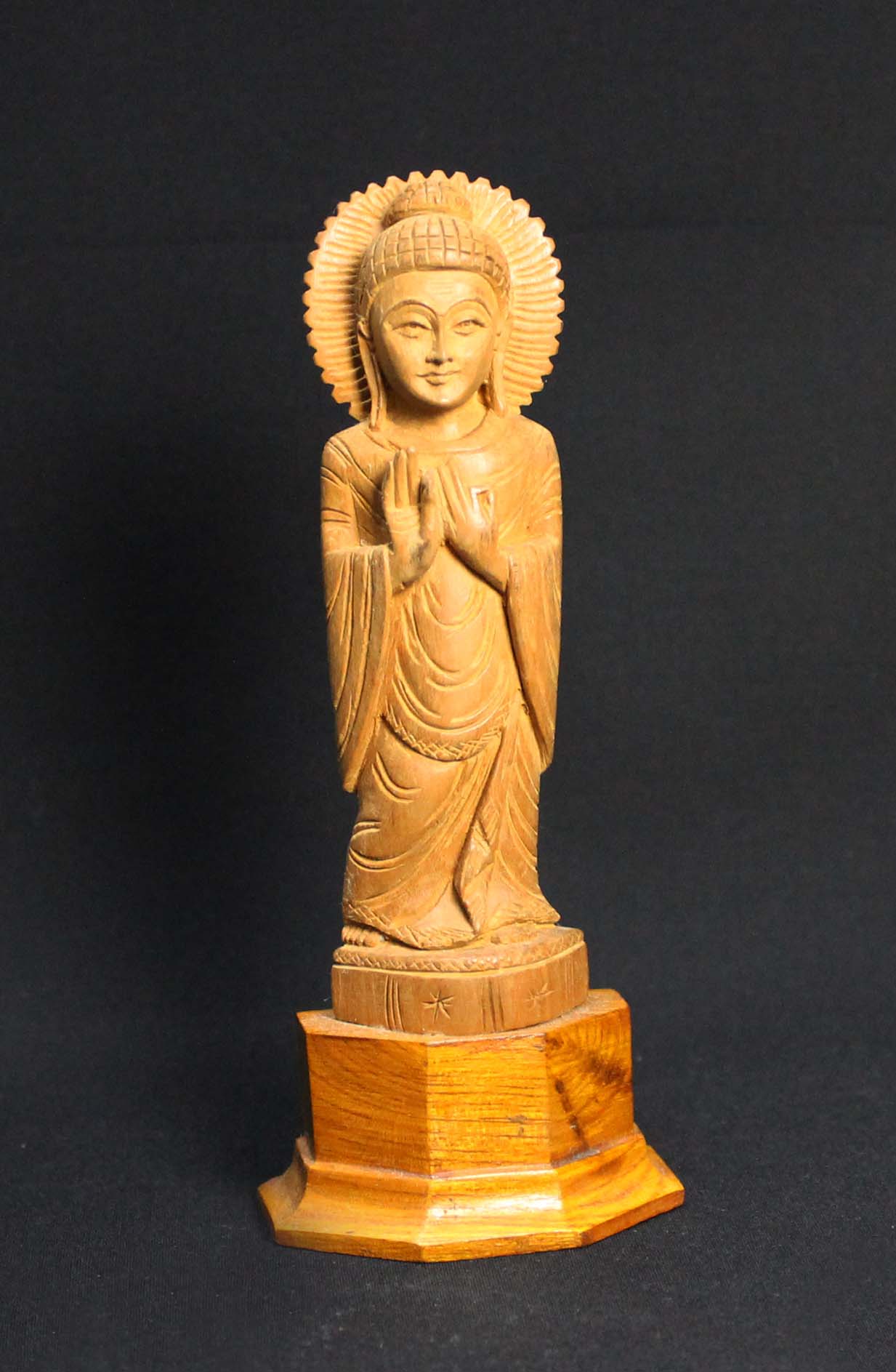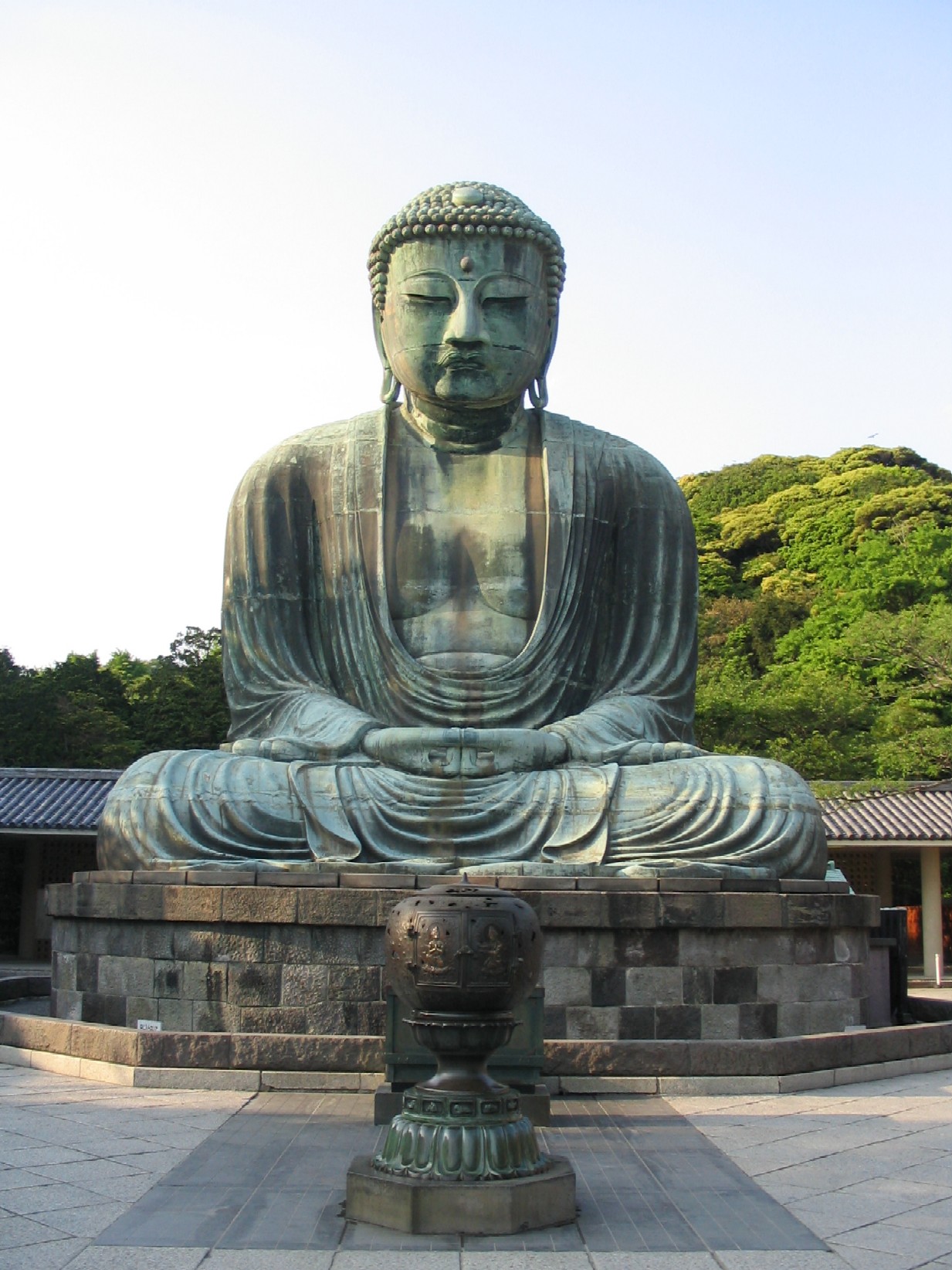Other Images of the Buddha
This section shows a small collection of Buddha figurines made from various materials including wood, stone and metal. The figurines originated in various countries and it may be interesting to compare them with the bronze figurines in the main collection. Pāḷi language terminology is used in this section about the Buddha. The numbered images are part of the Apsarah Gallery Collection.
1. Indian Sandalwood Buddha
 Material: natural sandalwood (Santalum album).
Material: natural sandalwood (Santalum album).
Posture: abhanga (standing on the left foot with the right leg bent at the knee) on a socle supported by a varnished wooden plinth with both hands showing the vitarkamudra (the mudra of teaching).
The age is estimated at 35 to 50 years.
2. Indian Marble Buddha
 Material: white marble.
Material: white marble.
Posture: padmasana
Seated on a vishvapadma or double lotus throne with the right hand showing the bhumisparshamudra, the mudra of touching or pointing to the earth.
Note the small ushnisha.
The age is estimated at 10 to 15 years.
3. Thai Jade Buddha
 Material: Jadeite
Material: Jadeite
Posture: padmasana
Seated on a plain socle with the hands showing the dhyanamudra, the mudra of meditation.
Note the ushnisha with a pointed ketumala common in Thailand.
The material is jadeite with a hardness of 6.5 – 7.0 Mohs, harder than nephrite jade, which has a hardness of 6.0 – 6.5 Mohs. Because of the hardness of the material, it is difficult to produce fine details, however, the raised areas can be highly polished.
The age is estimated at 35 to 50 years.
Kamakura Daibutsu – The Great Buddha of Kamakura
 Material: bronze.
Material: bronze.
Posture: padmasana with the hands showing the dhyanamudra (Japanese: jo-in), the mudra of meditation. This is a particular esoteric form of this mudra, where the index fingers form circles with the thumbs and is not found on sculpture in India.[1] The tightly curled hair has 656 curls.
This statue is of the Amitabha Buddha q.v. (Japanese: 阿弥陀如来 Amida Nyorai), located at the Kōtoku-in (高徳院) Buddhist temple located in Kamakura, Kanagawa Prefecture. It was completed in 1252 and was originally gilt. Since that time several halls built for its protection were damaged by storms and were rebuilt. The last one was destroyed in 1498 and since that year the statue has remained uncovered. The statue, 13.35 metres tall, is the second tallest Daibutsu statue in Japan after the Tōdai-ji Daibutsu, statue of the Vairocana Buddha, located in the city of Nara, which is 15 metres high. See details at the bottom of the page: A Brief History of Bronze Casting.
4. Japanese Silver Buddha
 Material: metallic silver-coated white metal.
Material: metallic silver-coated white metal.
Posture: padmasana
Seated on a varnished wooden socle with the hands showing the dhyanamudra, the mudra of meditation.
Note the tightly curled hair.
The head, robe and other features of this figurine appear to closely follow those of the above Kamakura Daibutsu, including the same esoteric mudra.
This figurine probably originated from Tokyo, Japan and the age is estimated at 35 to 100 years.
Kamagaya Daibutsu – The Great Buddha of Kamagaya
 Material: stone.
Material: stone.
Posture: seated on a vishvapadma in padmasana, showing the dhyanamudra, the mudra of meditation. The particular form of this mudra, where the thumbs are raised to form a triangle is rarely found in India, but commonly found on Wei dynasty statues in China from where it probably entered Japan.[2]
This statue is also of the Amitabha Buddha q.v. (Japanese: 阿弥陀如来 Amida Nyorai). The Kamagaya Great Buddha (鎌ヶ谷大仏 Kamagaya Daibutsu) is the smallest Daibutsu in Japan. It was completed in November 1776 and is located in Kamagaya, Chiba Prefecture.
The height of statue: 1.8 metres sitting on a pedestal of 0.5 metre giving a total height of 2.3 metres.
5. Japanese Gilt Buddha
 Material: gilt carved wood. The wooden carving is coated with gold leaf and laquer.
Material: gilt carved wood. The wooden carving is coated with gold leaf and laquer.
Posture: padmasana, showing the dhyanamudra, the mudra of meditation.
The hair is tightly curled, with a rounded ushnisha.
This is a figurine of the Amitabha Buddha q.v. (Japanese: 阿弥陀如来 Amida Nyorai). The head, robe and other features of this figurine appear to closely follow those of the above Kamagawa Daibutsu, including the same particular form of the mudra.
This figurine originated from Kyoto, Japan and the age is estimated at 35 to 50 years.
6. Burmese Reclining Buddha
 Material: Burmese teakwood (Tectona grandis), with dark red lacquer and gold leaf. The eyes are inlaid with mother-of-pearl with pupils of black onyx. The headband and edges of the robe are decorated with glass sequins. Posture: the Buddha is lying on his right side with his head supported by his right arm and hand. His left arm is lying on his left side. Statues of the reclining Buddha are associated with his parinibbana. Note the position of the right hand, supporting the his head and denoting that the Buddha is resting. If the right arm is lying next to the body, it denotes that the Buddha has attained parinibbana and has passed away. The Buddha attained parinibbana at the age of 80 years. His last words to his close disciple and attendant Ananda were: “Ananda, what I have taught and explained to you as dhamma and discipline will, at my passing, be your teacher.”
Material: Burmese teakwood (Tectona grandis), with dark red lacquer and gold leaf. The eyes are inlaid with mother-of-pearl with pupils of black onyx. The headband and edges of the robe are decorated with glass sequins. Posture: the Buddha is lying on his right side with his head supported by his right arm and hand. His left arm is lying on his left side. Statues of the reclining Buddha are associated with his parinibbana. Note the position of the right hand, supporting the his head and denoting that the Buddha is resting. If the right arm is lying next to the body, it denotes that the Buddha has attained parinibbana and has passed away. The Buddha attained parinibbana at the age of 80 years. His last words to his close disciple and attendant Ananda were: “Ananda, what I have taught and explained to you as dhamma and discipline will, at my passing, be your teacher.”
This figurine originates from Mandalay, which was the last royal capital of Burma from 1858 to 1885. The age is estimated at more than 100 years.
1. p.87, Saunders, Dale E., Mudrā, A study of Symbolic Gestures in Japanese Buddhist Sculpture, Princeton University Press, 1985.
2. p.86, Saunders, Dale E., Mudrā, A study of Symbolic Gestures in Japanese Buddhist Sculpture, Princeton University Press, 1985.